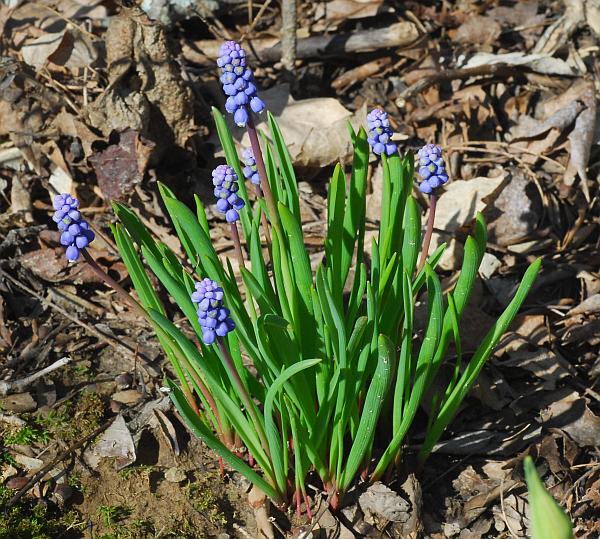Muscari botryoides (L.) Mill.
Common Grape Hyacinth

Introduced
CC = *
CW = 5
MOC = 17
© SRTurner
Muscari botryoides (L.) Mill.Common Grape Hyacinth | |
 |
Introduced CC = * CW = 5 MOC = 17 |
© SRTurner |
|
Family - Liliaceae Habit - Perennial forb with bulbs covered with a membranous to papery, smooth, outer coat, lacking the odor of onion or garlic, glabrous. Stems - Erect scape to 30 cm, glabrous, often glaucous, single from base, unbranched, green below, purplish in inflorescence.
Leaves - Basal, linear, entire, 10-25 cm long, 3-8 mm wide, flat, grooved or broadly "U" shaped in cross section, glabrous.
Inflorescence - Terminal dense indeterminate raceme to 6 cm. Pedicels to 5 mm long, glabrous, slightly elongating in fruit.
Flowers - Sepals and petals fused nearly to the tips, urn-shaped to globose, blue, glabrous, with 6 small lobes at apex. Sterile, terminal flowers few, ascending, with stalks 0.5-5.0 mm long, with perianth 2-4 mm long. Fertile flowers with stalks 2-5 mm long at flowering, elongating in fruit, the perianth 4-5 mm long. Stamens 6, fused to base of perianth, included. Style 1, included. Stigma 3-lobed. Ovary superior, 3-locular.
Fruits - Capsules, 3-angled, glabrous, glaucous, 5 mm long and broad. Seeds 2 per locule, black.
Flowering - April - May. Habitat - Typically cultivated, often persistent, occasionally escaped, in fields, pastures, old homesites, lawns, cemeteries, roadsides, railroads, and disturbed mesic areas. Origin - Native to Europe. Lookalikes - M. racemosum. Other info. - This is a very popular plant in cultivation, both in Missouri and in many other parts of the U.S., because it is easy to grow, interesting in appearance, and very early to flower in spring. The small blue inflated flowers are hard to miss and the plant is easily identified. It can be distinguished from M. racemosum by its flat leaves; the leaves of the latter species are tubular. Photographs taken off Strathbury Rd., Platte County, MO., 7-2-00, and in Brown Summit, NC., 4-5-03 (DETenaglia); also at Weldon Spring Conservation Area, St. Charles County, MO, 4-5-2014 and 3-30-2020 (SRTurner). |